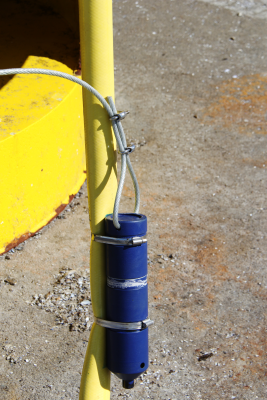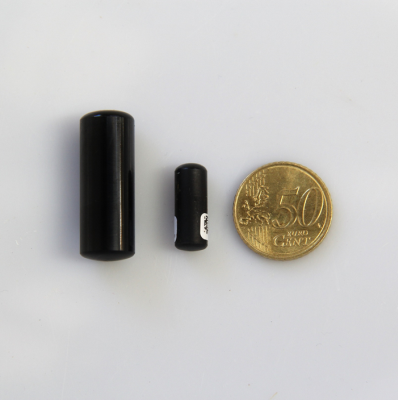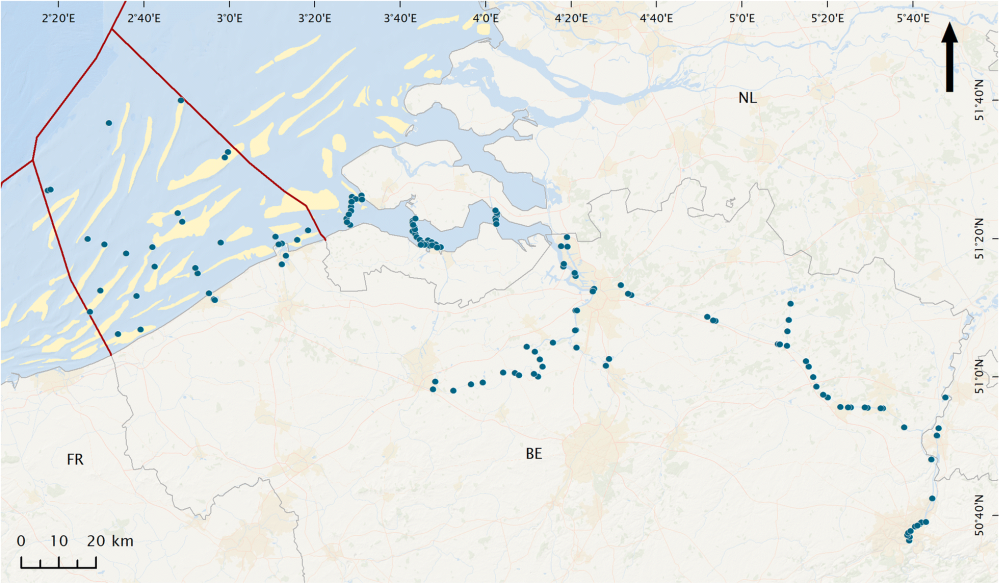You are here
Fish acoustic receiver network
Telemetry is an increasingly applied technique to investigate the behavioural ecology of aquatic animals in the wild. These animals are equipped with electronic tags, implanted internally or externally by means of a minor surgery. As part of the Belgian LifeWatch observatory, fishes are being tracked with different telemetry types by Ghent University, the Flanders Marine Institute and the Research Institute for Nature and Forest.
Acoustic telemetry
In acoustic telemetry, the acoustic signals of transmitter tags can be detected by a network of receivers. Upon detection, the information of the unique ID-code of the transmitter is stored on the receiver together with an exact timing of the event. When applicable, data from incorporated sensors in the tags (e.g. temperature, pressure and acceleration) can be stored as well. The detection probability of the receivers can change substantially depending on the environment they are deployed, but on average a high probability (> 70 %) is achieved till 200 m.
Within the LifeWatch project, the aforementioned partners established the Permanent Belgian Acoustic Receiver Network (PBARN). The PBARN currently (January 2019) consists of 160 permanently installed receivers in the Belgian part of the North Sea, the Schelde Estuary, Dijle, Rupel, Albert Canal and Meuse River. The coverage of PBARN allows tracking of fresh water, marine and diadromous (which migrate between freshwater and marine environments to complete their life cycle) fish in different environments. Since the start of the network in 2014, over 800 animals have been tagged, attributed to 16 species:
- Atlantic cod (Gadus morhua Linnaeus, 1758) (read more about the Atlantic cod research here)
- Atlantic salmon (Salmo salar Linnaeus, 1758)
- Common carp (Cyprinus carpio Linnaeus, 1758)
- Common dab (Limanda limanda (Linnaeus, 1758))
- Common roach (Rutilus rutilus (Linnaeus, 1758))
- European chub (Squalius cephalus (Linnaeus, 1758))
- European eel (Anguilla anguilla (Linnaeus, 1758)) (read more about the European eel research here)
- European flounder (Platichthys flesus (Linnaeus, 1758))
- European plaice (Pleuronectes platessa Linnaeus, 1758)
- European seabass (Dicentrarchus labrax (Linnaeus, 1758)) (read more about the European seabass research here)
- Lemon sole (Microstomus kitt (Walbaum, 1792))
- River lamprey (Lampetra fluviatilis (Linnaeus, 1758))
- Sea lamprey (Petromyzon marinus Linnaeus, 1758)
- Starry smooth-hound (Mustelus asterias Cloquet, 1819)
- Twaite shad (Alosa fallax (Lacepède, 1803)) (read more about the European seabass research here)
- Wels catfish (Silurus glanis Linnaeus, 1758)
Data storage tags
In contrast to acoustic transmitters, data storage tags (DSTs) do not emit signals, but log and store environmental data (e.g. temperature and pressure). The advantage of this technique is that it does not rely on moored receivers. However, acoustic data storage tags are applied as well: these devices both emit acoustic signals to be detected by the PBARN and log environmental variables. Nonetheless, DSTs need to be retrieved to obtain the recorded data. Based on those data, the tagged fish its trajectory can be reconstructed. Hence, if you find a red object on a beach, please contact jan.reubens@vliz.be and get your reward!




From left to right: Mooring of an acoustic receiver (©VLIZ) - A V9 acoustic tag (Vemco) (©VLIZ) - A pop-off data storage tag (pDST) (©VLIZ) - An Acoustic Data Storage Tag (ADST) (©VLIZ)

The Permanent Belgian Acoustic Receiver Network (PBARN)
Data
Data can be accessed via the LifeWatch Data Explorer for fish telemetry data.
Metadata is available at:
- LifeWatch observatory data: fish acoustic receiver network, More
Useful links
- LifeWatch Data Explorer - Fish telemetry data: Access and explore the LifeWatch data.
- ETN: Access, store and share fish tracking data on the European Tracking Network data platform.
Media & outreach
- Fel gekleurde oranje kokertjes op het strand? Het gaat om zendertjes die ingeplant werden bij vissen
- Met deze zendertjes kan je geld verdienen
- Het bewogen leven van Zeebrugse onderwaterbewoners
- BBC Radio Foyle, Mark Patterson Show: European Tracking Nertwork (ETN) annual meeting (day 2)
- BBC Radio Foyle, Mark Patterson Show: European Tracking Nertwork (ETN) annual meeting
- Mapping the eel migration routes
- European Tracking Network for fish has reached over 500 million detections
- Use your gaming skills to save the eel!
- The pursuit of seabass and its conservation: electronic tagging
- The tripod frame: mooring acoustic receivers on the seabed
- Hengelen om vissenlevens te redden
- The Mystery of European Eel migration
- Tracking European eels in the English Channel
- Exhibition at de Blankaart: Paling in ‘t rood
- Seminar at de Blankaart: Avondje Over… Van de paling geen nieuws!?
- De mysterieuze zeereis van de paling
- Onze paling is een zorgenkind
- Zenderonderzoek moet paling van ondergang redden
- Paling in 't rood
- Paaiproces van de paling is nog altijd door niemand waargenomen: hoe doen ze het toch?
- Strandjutters kunnen 50 euro verdienen met palingzender
- De parende paling
- Hoe zit het met de Belgische vis en hoe wordt dat eigenlijk gemeten?
- Critically endangered eels arriving in our Flemish rivers after a 6000 kilometer journey
- Shortcuts voor Paling
- Aristoteles en soortenverspreiding en migratiepatronen
- Does rain trigger the migration of silver eels?
- Moeflons op de Veluwe en palingen zenderen
Most recent publications
-
Goossens, J.; Buyse, J.; Bruneel, S.; Verhelst, P.; Goethals, G.; Torreele, E.; Moens, T.; Reubens, J. (2022). Taking the time for range testing: an approach to account for temporal resolution in acoustic telemetry detection range assessments. Animal Biotelemetry 10(1): 17. https://dx.doi.org/10.1186/s40317-022-00290-2 [link to IMIS record]
-
Van der Knaap, I.; Slabbekoorn, H.; Moens, T.; Van den Eynde, D.; Reubens, J. (2022). Effects of pile driving sound on local movement of free-ranging Atlantic cod in the Belgian North Sea. Environ. Pollut. 300: 118913. https://dx.doi.org/10.1016/j.envpol.2022.118913 [link to IMIS record]
-
Verhelst, P.; Reubens, J.; Coeck, J.; Moens, T.; Simon, J.; Van Wichelen, J.; Westerberg, H.; Wysujack, K.; Righton, D. (2022). Mapping silver eel migration routes in the North Sea. NPG Scientific Reports 12(1): 318. https://dx.doi.org/10.1038/s41598-021-04052-7 [link to IMIS record]
-
Van der Knaap, I.; Reubens, J.; Thomas, L.; Ainslie, M.A.; Winter, H.V.; Hubert, J.; Martin, B.; Slabbekoorn, H. (2021). Effects of a seismic survey on movement of free-ranging Atlantic cod. Curr. Biol. 31(7): 1555-1562. https://dx.doi.org/10.1016/j.cub.2021.01.050 [link to IMIS record]
-
Reubens, J.; Aarestrup, K.; Meyer, C.; Moore, A.; Økland, F.; Afonso, P. (2021). Compatibility in acoustic telemetry. Animal Biotelemetry 9(1): 33. https://dx.doi.org/10.1186/s40317-021-00253-z [link to IMIS record]
-
Van der Knaap, I.; Slabbekoorn, H.; Winter, H.V.; Moens, T.; Reubens, J. (2021). Evaluating receiver contributions to acoustic positional telemetry: a case study on Atlantic cod around wind turbines in the North Sea. Animal Biotelemetry 9(1): 14. https://dx.doi.org/10.1186/s40317-021-00238-y [link to IMIS record]
-
Verhelst, P.; Reubens, J.; Buysse, D.; Goethals, P.; Van Wichelen, J.; Moens, T. (2021). Toward a roadmap for diadromous fish conservation: the Big Five considerations. Front. Ecol. Environ. 19(7): 396-403. https://hdl.handle.net/10.1002/fee.2361 [link to IMIS record]
-
Bruneel, S.; Verhelst, P.; Reubens, J.; Baetens, J.M.; Coeck, J.; Moens, T.; Goethals, P. (2020). Quantifying and reducing epistemic uncertainty of passive acoustic telemetry data from longitudinal aquatic systems. Ecological Informatics 59: 101133. https://dx.doi.org/10.1016/j.ecoinf.2020.101133 [link to IMIS record]
-
Bruneel, S.; Verhelst, P.; Reubens, J.; Luca, S.; Coeck, J.; Moens, T.; Goethals, P. (2020). Combining disciplines: dealing with observed and cryptic animal residencies in passive telemetry data by applying econometric decision-making models. Ecol. Model. 438: 109340. https://dx.doi.org/10.1016/j.ecolmodel.2020.109340 [link to IMIS record]
-
Goossens, J.; T’Jampens, M.; Deneudt, K.; Reubens, J. (2020). Mooring scientific instruments on the seabed – Design, deployment protocol and performance of a recoverable frame for acoustic receivers. Methods Ecol. Evol. 11(8): 974-979. https://dx.doi.org/10.1111/2041-210x.13404 [link to IMIS record]
-
Vergeynst, J.; Pauwels, I.; Baeyens, R.; Coeck, J.; Nopens, I.; De Mulder, T.; Mouton, A. (2019). The impact of intermediate-head navigation locks on downstream fish passage. River Res. Applic. 35(3): 224-235. https://hdl.handle.net/10.1002/rra.3403 [link to IMIS record]
-
Reubens, J.; Verhelst, P.; van der Knaap, I; Wydooghe, B.; Milotic, T.; Deneudt, K.; Hernandez, F.; Pauwels, I. (2019). The need for aquatic tracking networks: the permanent Belgian Acoustic Receiver Network. Animal Biotelemetry 7(2). https://hdl.handle.net/10.1186/s40317-019-0164-8 [link to IMIS record]
-
Verhelst, P.; Bruneel, S.; Reubens, J.; Coeck, J.; Goethals, P.; Oldoni, D.; Moens, T.; Mouton, A. (2018). Selective tidal stream transport in silver European eel (Anguilla anguilla L.) – Migration behaviour in a dynamic estuary. Est., Coast. and Shelf Sci. 213: 260-268. https://hdl.handle.net/10.1016/j.ecss.2018.08.025 [link to IMIS record]
-
Verhelst, P.; Baeyens, R.; Reubens, J.; Benitez, J.-P.; Coeck, J.; Goethals, P.L.M.; Ovidio, M.; Vergeynst, J.; Moens, T.; Mouton, A.M. (2018). European silver eel (Anguilla anguilla L.) migration behaviour in a highly regulated shipping canal. Fish. Res. 206: 176-184. https://hdl.handle.net/10.1016/j.fishres.2018.05.013 [link to IMIS record]
-
Verhelst, P.; Buysse, D.; Reubens, J.; Pauwels, I.; Aelterman, B.; Van Hoey, S.; Goethals, P.; Coeck, J.; Moens, T.; Mouton, A.M. (2018). Downstream migration of European eel (Anguilla anguilla L.) in an anthropogenically regulated freshwater system: Implications for management. Fish. Res. 199: 252-262. https://hdl.handle.net/10.1016/j.fishres.2017.10.018 [link to IMIS record]
-
Verhelst, P.; Reubens, J.; Pauwels, I.; Buysse, D.; Aelterman, B.; Van Hoey, S.; Goethals, P.; Moens, T.; Coeck, J.; Mouton, A. (2018). Movement behaviour of large female yellow European eel (Anguilla anguilla L.) in a freshwater polder area. Ecol. Freshw. Fish. 27(1): 471-480. https://hdl.handle.net/10.1111/eff.12362 [link to IMIS record]
-
Verhelst, P.; De Meyer, J.; Reubens, J.; Coeck, J.; Goethals, P.; Moens, T.; Mouton, A.M. (2018). Unimodal head-width distribution of the European eel (Anguilla anguilla L.) from the Zeeschelde does not support disruptive selection. PeerJ 6: e5773. https://hdl.handle.net/10.7717/peerj.5773 [link to IMIS record]
-
Bruneel, S.; Gobeyn, S.; Verhelst, P.; Reubens, J.; Moens, T.; Goethals, P. (2018). Implications of movement for species distribution models - rethinking environmental data tools. Sci. Total Environ. 628-629: 893-905. https://hdl.handle.net/10.1016/j.scitotenv.2018.02.026 [link to IMIS record]
-
Reubens, J.; Verhelst, P.; van der Knaap, I; Deneudt, K.; Moens, T.; Hernandez, F. (2018). Environmental factors influence the detection probability in acoustic telemetry in a marine environment: results from a new setup. Hydrobiologia Online: 1–14. https://hdl.handle.net/10.1007/s10750-017-3478-7 [link to IMIS record]
